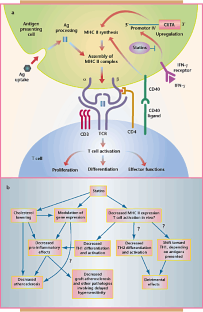Immunomodulation: a new role for statins? (original) (raw)
- News & Views
- Published: December 2000
Nature Medicine volume 6, pages 1311–1312 (2000)Cite this article
- 439 Accesses
- 92 Citations
- Metrics details
Statins reduce the expression of the class II major histocompatibility complex (MHCII) by arterial cells, leading to a decreased T-cell response. This indicates that statins may be useful in treating graft atherosclerosis and other chronic inflammatory conditions. (pages 1399–1402)
This is a preview of subscription content, access via your institution
Relevant articles
Open Access articles citing this article.
Access options
Subscribe to this journal
Receive 12 print issues and online access
$209.00 per year
only $17.42 per issue
Buy this article
- Purchase on SpringerLink
- Instant access to full article PDF
Prices may be subject to local taxes which are calculated during checkout
Additional access options:
Figure 1: Statin modulation of the immune response.

Bob Crimi
References
- Maron, D.J., Fazio, S. & Linton, M.F. Current perspectives on statins. Circulation 101, 207–223 (2000).
Article CAS Google Scholar - Faggiotto, A. & Paoletti, R. State-of-the-Art lecture. Statins and blockers of the renin-angiotensin system: vascular protection beyond their primary mode of action. Hypertension 34, 987–996 (1999).
Article CAS Google Scholar - Kwak, B., Mulhaupt, F., Myit, S. & Mach, F. Statins (HMG-CoA Reductase Inhibitors) as a novel type of immunosuppressor. Nature Med. 6, 1399–1402 (2000).
Article CAS Google Scholar - Kobashigawa, J.A., et al. Effect of pravastatin on outcomes after cardiac transplantation. N. Engl. J. Med. 333, 621–627 (1995).
Article CAS Google Scholar - Wenke, K., et al. Simvastatin reduces graft vessel disease and mortality after heart transplantation: a four-year randomized trial. Circulation 96, 1398–1402 (1997).
Article CAS Google Scholar - Mach, B., Steimle, V., Martinez-Soria, E. & Reith, W. Regulation of MHC class II genes: Lessons from a disease. Annu. Rev. Immunol. 14, 301–331 (1996).
Article CAS Google Scholar - Endres, M., et al. Stroke protection by 3-hydroxy-3-methylglutaryl (HMG)-CoA reductase inhibitors mediated by endothelial nitric oxide synthase. Proc. Natl. Acad. Sci. USA 95, 8880–8885 (1998).
Article CAS Google Scholar - Guijarro, C., et al. 3-hydroxy-3-methylglutaryl coenzyme A reductase and isoprenylation inhibitors induce apoptosis of vascular smooth muscle cells in culture. Circ. Res. 83, 490–500 (1998).
Article CAS Google Scholar - Liu, L., et al. Integrin-dependent leukocyte adhesion involves geranylgeranylated protein(s). J. Biol. Chem. 274, 33334–33340 (1999).
Article CAS Google Scholar - Genain, C.P. & Zamvil, S.S. Specific immunotherapy: One size does not fit all. Nature Med. 6, 1098–1100 (2000).
Article CAS Google Scholar - Palinski, W. & Witztum, J.L. Immune responses to oxidative neoepitopes on LDL and phospholipids modulate the development of atherosclerosis. J. Intern. Med. 247, 371–380 (2000).
Article CAS Google Scholar - Napoli, C., et al. Fatty streak formation occurs in human fetal aortas and is greatly enhanced by maternal hypercholesterolemia. Intimal accumulation of low density lipoprotein and its oxidation precede monocyte recruitment into early atherosclerotic lesions. J. Clin. Invest. 100, 2680–2690 (1997).
Article CAS Google Scholar
Author information
Authors and Affiliations
- Department of Medicine, 0682 University of California, San Diego 9500 Gilman Drive, MTF 110, La Jolla, 92093-0682, California
Wulf Palinski
Authors
- Wulf Palinski
You can also search for this author inPubMed Google Scholar
Rights and permissions
About this article
Cite this article
Palinski, W. Immunomodulation: a new role for statins?.Nat Med 6, 1311–1312 (2000). https://doi.org/10.1038/82107
- Issue Date: December 2000
- DOI: https://doi.org/10.1038/82107